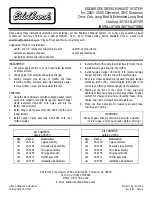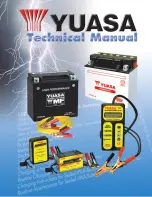
||
WHEELS AND TIRES
436
NOTE
Please be aware that the following tire desig-
nation is an
example only
and that this par-
ticular tire may not be available on your vehi-
cle.
1.
215
: the width of the tire (in millimeters)
from sidewall edge to sidewall edge. The
larger the number, the wider the tire.
2.
65
: The ratio of the tire's height to its width
in percent.
3.
R
: Radial tire (the designation
RF
and the
symbol indicate that the vehicle is
equipped with optional self-supporting run
flat tires
2
.
4.
15
: The diameter of the wheel rim (in
inches).
5.
95
: The tire's load index. In this example, a
load index of 95 equals a maximum load of
1521 lbs (690 kg).
6.
H
: The tire's speed rating, or the maximum
speed at which the tire is designed to be
driven for extended periods of time, carrying
a permissible load for the vehicle, and with
correct inflation pressure. For example, H
indicates a speed rating of 130 mph
(210 km/h).
NOTE
The tire's load index and speed rating may
not appear on the sidewall because they are
not required by law.
7.
M+S or M/S
= Mud and Snow,
AT
= All Ter-
rain,
AS
= All Season
8.
U.S. DOT Tire Identification Number
(TIN)
: This begins with the letters "DOT" and
indicates that the tire meets all federal
standards. The next two numbers or letters
are the plant code where it was manufac-
tured, the next two are the tire size code and
the last four numbers represent the week
and year the tire was built. For example,
1510 means that the tire was manufactured
during week 15 of 2010. The numbers in
between are marketing codes used at the
manufacturer's discretion. This information
helps a tire manufacturer identify a tire for
safety recall purposes.
9.
Tire Ply Composition and Material
Used
: Indicates the number of plies indi-
cates or the number of layers of rubber-
coated fabric in the tire tread and sidewall.
Tire manufacturers also must indicate the ply
materials in the tire and the sidewall, which
include steel, nylon, polyester, and others.
10.
Maximum Load
: Indicates the maximum
load in pounds and kilograms that can be
carried by the tire. Refer to the vehicle's tire
information placard located on the B-Pillar
for the correct tire pressure for your vehicle.
11.
Treadwear, Traction, and Temperature
grades
.
12.
Maximum permissible inflation
pressure:
the greatest amount of air pres-
sure that should ever be put in the tire. This
limit is set by the tire manufacturer.
Speed Symbol
A tire's Speed Symbol (SS) indicates the maxi-
mum speed for which the tire has been certified
and should be at least equivalent to the vehicle's
top speed.
Winter tires, with our without studs, are excep-
tions and may use a lower SS. When winter tires
are installed, the vehicle may not be driven faster
than the tires' SS.
The vehicle's speed should always be determined
by the posted speed limit and traffic and road
conditions, not the tire's SS.
The following table indicates the maximum per-
missible speed for each SS.
2
Self-supporting run flat tires may not be available on all models
Summary of Contents for XC90 T8 TwinEngine Plug-In Hybrid
Page 1: ...WEB EDITION OWNER S MANUAL...
Page 2: ......
Page 13: ...INTRODUCTION...
Page 17: ...INTRODUCTION 15 Overview...
Page 19: ...INTRODUCTION 17 Preparations for charging the hybrid battery p 372 Starting the engine p 364...
Page 58: ......
Page 59: ...SAFETY...
Page 94: ...SAFETY 92 Related information Airbag system p 87 Seat belts p 62...
Page 95: ...INSTRUMENTS AND CONTROLS...
Page 175: ...CLIMATE...
Page 204: ......
Page 205: ...LOADING AND STORAGE...
Page 221: ...LOCKS AND ALARM...
Page 246: ......
Page 247: ...DRIVER SUPPORT...
Page 339: ...STARTING AND DRIVING...
Page 396: ......
Page 397: ...INFOTAINMENT...
Page 434: ......
Page 435: ...WHEELS AND TIRES...
Page 462: ......
Page 463: ...MAINTENANCE AND SERVICING...
Page 508: ......
Page 509: ...SPECIFICATIONS...
Page 511: ...SPECIFICATIONS 509 Location of labels...
Page 533: ......
















































